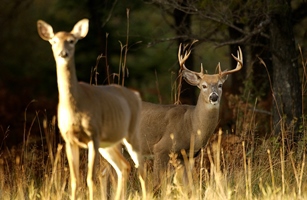Prospects for the 2015 big-game hunting and furbearer hunting seasons are very good, say Department of Natural Resources wildlife biologists. Michigan offers a diversity of species and a wide variety of seasons to maximize recreational opportunity.
Here’s a quick overview of some of the upcoming seasons:
Bear
Season: Bear licenses are issued by a preference-point system for specific time periods and geographic areas. A total of 6,951 licenses were available.
 Hunting on the mainland of the Upper Peninsula runs Sept. 10-Oct. 26. On Drummond Island, the season is Sept. 10-Oct. 21. In the northern Lower Peninsula, the season is Sept. 20-28 and Oct. 2-8 (archery only) in the Red Oak unit; Sept 11-26 in the northern Baldwin unit and Sept 20-28 in the entire unit; and Sept. 20-28 in the Gladwin unit. In the Upper Peninsula, the first five days are for bait-only hunting only. In the Lower Peninsula the first day of the season is bait-only and the Red Oak archery-only season is bait-only. The last two days of the Red Oak, Baldwin and Gladwin area are dogs-only.
Hunting on the mainland of the Upper Peninsula runs Sept. 10-Oct. 26. On Drummond Island, the season is Sept. 10-Oct. 21. In the northern Lower Peninsula, the season is Sept. 20-28 and Oct. 2-8 (archery only) in the Red Oak unit; Sept 11-26 in the northern Baldwin unit and Sept 20-28 in the entire unit; and Sept. 20-28 in the Gladwin unit. In the Upper Peninsula, the first five days are for bait-only hunting only. In the Lower Peninsula the first day of the season is bait-only and the Red Oak archery-only season is bait-only. The last two days of the Red Oak, Baldwin and Gladwin area are dogs-only.
Outlook: Bear hunting continues to be excellent in Michigan. With a population estimated to be in the 11,000 range (not counting cubs), the DNR has made 11,742 licenses available and anticipates a harvest of about 1,400 bruins.
Elk
Season: Hunt Period 1 is Aug. 25-28, Sept 11-14 and Sept. 25-28 in most of elk range. Hunt Period 2 is Dec. 5-13 in all of elk range. Hunt Period 3, Jan. 13-17, will only be held if needed.
Outlook: Michigan’s elk population, which was above goal for a number of years, has been reduced to a level more in line with management goals. As a result, fewer licenses are available than in some recent seasons. A total of 100 licenses were issued by lottery. The early season is held largely outside the core elk range. In December, hunters are issued licenses for specific units within the core elk range, but hunters may opt to hunt outside the core area as well. If wildlife managers determine the harvest was insufficient to meet management goals, a January hunt will be held with additional licenses available to hunters who have already applied.
Deer
Season: An early antlerless-only hunt is Sept. 19-20 in selected counties on private land only. The Liberty Hunt, for youths and qualified hunters with disabilities, is also Sept. 19-20. The Independence Hunt, for qualified hunters with disabilities, is Oct. 15-18. Archery season is Oct.1-Nov. 14, and Dec. 1-Jan. 1, statewide. Firearms season is Nov.15-30, statewide. Muzzleloading seasons are Dec. 4-13 in Zone 1 (Upper Peninsula) and Zone 2 (Northern Lower Peninsula) and Dec. 4-20 in Zone 3 (southern Michigan).
A late antlerless hunt in selected Lower Peninsula counties on private land is Dec. 21-Jan. 1. Please see the 2015 Hunting and Trapping Digest and the 2015 Antlerless Deer Digest for pertinent details.
The season limit is two bucks. Hunters must purchase a combo license to take two bucks, one of which must have at least four antler points on one side. Hunters who purchase the deer license may harvest a buck with at least one antler that is 3 inches in length unless hunting in an area with antler point restriction. For specific antler point restriction information by location see pages 32 and 33 in the Hunting and Trapping Digest.
Hunters may take one antlerless deer per antlerless deer license. Antlerless licenses are available by quotas for each deer management unit (DMU) by public and private land. In most DMUs, hunters are restricted to five antlerless licenses. IN DMU 487, hunters may buy up to 10 licenses. There is no restriction on antlerless licenses in the nine-township Core Chronic Wasting Disease Area – DMU 333 – that encompasses parts of Ingham, Clinton and Shiawassee counties. Please see the 2015 Antlerless Deer Digest for details.
Outlook: Overall, there is reason for optimism heading into this deer season. Preliminary field reports indicate a good fawn crop and healthy-looking deer. Last year an estimated 614,593 hunters spent 8.8  million days afield, harvesting roughly 329,000 deer, a significant decrease from 2013. Some 41 percent of hunters successfully tagged at least one deer last year.
million days afield, harvesting roughly 329,000 deer, a significant decrease from 2013. Some 41 percent of hunters successfully tagged at least one deer last year.
The deer harvest in the Upper Peninsula is expected to be low again following a series of difficult winters and the subsequent effects on the deer herd. In addition, the population may take longer to rebound due to the number of predators on the landscape. Therefore, new regulation changes aimed at protecting antlerless deer have been enacted, which includes removing the antlerless option from archery season for license and combo license holders.
Prospects in southern Michigan may be improved because of a later-than-usual corn harvest last year. Hunters are reminded that the progress of the corn harvest has an effect on early season hunting results, but the corn harvest is almost always complete by the end of the regular firearms season, and good opportunities remain during muzzleloader, late-archery and late-antlerless seasons. Hunters also are encouraged to bring their deer to check stations. Check the DNR website (www.michigan.gov/deer) for details.
Bobcat
Season: Jan. 1-March 1 in Unit A (Upper Peninsula except Drummond Island); Unit B (Drummond Island); and Unit C (Alcona, Alpena, Antrim, Charlevoix, Cheboygan, Emmett, Montmorency, Oscoda, Otsego and Presque Isle counties). Jan. 1-Feb 1 in Unit D (Clare, Crawford, Gladwin, Iosco, Kalkaska, Missaukee, Ogemaw, Osceola, Roscommon and Wexford counties and Arenac north of M-61 and west of I-75). Jan. 1-11 in unit E (Leelanau, Benzie, Grand Traverse, Manistee, Mason and Lake counties); and Unit F (Oceana, Newaygo, Mecosta, Isabella and Midland counties, the reminder of Arenac County and part of Bay County).
The limit is two per season, but only one may be taken from Units C, D, E and F combined, and only one may be taken in Unit B.
Outlook: Bobcats are found primarily in the northern two-thirds of Michigan. The population is stable to increasing in the Upper Peninsula, where harvests vary widely because of snow conditions and road access. The population also is stable to increasing in the Lower Peninsula. Hunters are reminded that in addition to a fur harvester license, they must acquire a (free) bobcat kill tag in advance of hunting. Hunters must immediately apply the kill tag to the animal when they kill a bobcat and the carcass must be presented to a DNR office within 10 days of the close of the season. DNR personnel will collect data including the date of kill, location and method of harvest, and the skull. The bobcat pelt will be sealed by the DNR.
Coyote
Season: July 15–April 15 statewide. Coyotes may be taken year-round on private property if doing damage or about to do damage. There is no bag limit. Resident hunters may take coyotes on a base hunting license or fur harvester license.
Outlook: Coyotes are widespread across the state and abundant in some areas. Retiring, often nocturnal creatures, coyotes may be present in significant numbers without being visible. Coyote hunters in the Upper Peninsula are advised to be cautious not to confuse young wolves for coyotes. Coyotes may be hunted at night, but hunters are restricted to .22 caliber or smaller rifles or handguns, archery gear or crossbows, or shotguns containing shells with shot smaller than buck shot. Check the 2015 Michigan Hunting and Trapping Digest for additional information.
Raccoon
Season: Oct. 1-Jan. 31 statewide, though they may be taken year-round on private property if doing or about to do damage. There is no bag limit.
Outlook: Raccoons are abundant and widespread, found in all habitats, but are partial to hardwood stands, especially along waterways or near agricultural fields. Raccoons often are hunted at night with hounds. Roughly 75,000 are taken by hunters each year. Check the 2015 Michigan Hunting and Trapping Digest for restrictions on firearms and equipment.
Fox
Season: Oct. 15-March 1. There is no bag limit.
Outlook: Both red and gray fox are found across Michigan. The more numerous red fox are found largely in agricultural areas with mixed habitat, including fence rows, fallow fields and shrub land, especially adjacent to wood lots or waterways. Gray fox typically are found in woodlands. Although they are found in all counties, fox numbers vary widely from abundant to uncommon. Generally, fox do not compete well with coyotes, so in areas with large coyote populations they may be hard to find. Although they are commonly hunted with hounds, often in conjunction with coyotes, hunting with predator calls has become increasingly popular. Hunters are reminded that they must have a fur harvester license to take fox.
For more information, including links to the latest Michigan hunting digests, visit www.michigan.gov/hunting.
 Keweenaw Report Your Source for Local News and Sports
Keweenaw Report Your Source for Local News and Sports





